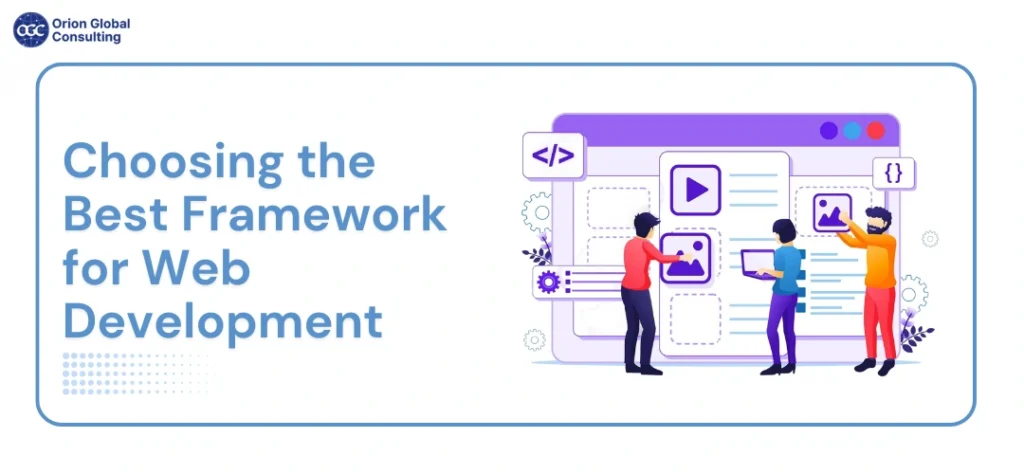
Let’s be real: choosing the best framework for web development today is like trying to choose a show on Netflix with your friends—too many choices and strong opinions, right? The result is you’ll possibly just give up and watch The Office again.
But what if we could focus and the essentials and determine once and for all which frameworks are really worth your time?
If you’ve ever Googled:
- “What is a framework in web development?”,
- “top web frameworks”,
or simply preaching to deaf ears,
- “Which is the best web development framework?!”
—This blog is for you.
Grab your coffee (or code-infused energy drink of choice) and let’s look at high-performance and widely popular web frameworks of our time.
First Things First: What is a Framework in Web Development?
Imagine constructing a house. Would you rather chisel your own bricks and mix your cement… or just buy materials, use power tools, and follow a blueprint?
Yeah, that’s what a web development framework does. It provides you with structure and shortcuts to build amazing web apps without reinventing the wheel or the router, the database layer, or the 1,400th login form.
Whether you’re developing a basic website framework or an advanced web application framework, using a sound framework signifies faster development and fewer bugs.
Now… Which One Is Actually the Best Web Framework?
Here’s the catch: there’s no single “best framework” for every project. In place, there are best fits depending on your requirement—err, tech stack, team size, app goals, and coffee intake.
But let’s get into some of the most popular web development frameworks and determine where each shines (and collapses).
React: The Most Popular Web Framework for Frontend Professionals

Technically a library, but whatever—React has more fan base than most. It is component-based, fast like a light, and runs like butter (when you don’t overfill your state).
Everyone’s using it: Instagram, Netflix, Discord, and more…
Look at it like a universal adapter for frontend UIs, and with Next.js, it scales up into a complete web application framework with server-side rendering, routing, and SEO smarts.
Best for: Interactive UIs. SPAs. Dashboards. Startups
Modern twist: React Server Components and Suspense are making the difference.
Angular: The Business-Friendly Web Application Framework
If React is the minimalist, Angular is the full-course buffet. It’s packed with everything: form validation, routing, TypeScript, RxJS, DI, testing tools, and enough structure to keep your code in line even if your team is… less structured.
If React is simple and focused, Angular is complete and all-inclusive. It comprises everything: from validation, routing, TypeScript, RxJS, DI, testing tools, and sufficient structure to keep your code aligned even if your team is… less structured.
Undoubtedly, there is a learning curve. But once you climb that mountain, the view is amazing.
Best for: Enterprise apps. Large dev teams. Strict codebases.
Modern edge: Standalone components. Ivy. Better dev experience than ever.
Vue.js: A Modern Web App Framework That’s Fast and Easy
You know that one developed who’s a total master but somehow never stressed out? That’s Vue.
It’s approachable, lightweight, and flexible. It is perfect for beginners but powerful enough to build massive apps (just ask Alibaba or Xiaomi).
Best for: Startups. Solo developers. Quick MVPs. Projects that need to move fast.
Vue 3’s Composition API = reactivity magic with serious scalability.
Express: A Popular Web Development Framework for Fast Backends
Welcome to the backend! Express is Node.js’s favorite child—fast and unopinionated. It’s been strengthening APIs, server-side apps, and web development frameworks built on JS for years.
Want REST? You got it. Want middleware galore? Oh, my friend!
Best for: APIs. Microservices. Backend logic that Just Works™.
Pro tip: Add TypeScript and you’ve got: Lean. Mean. Backend machine.
Django: The Best Python Web Application Framework
You want power and speed? Django said, “Hold my ORM.” It is built for developers who want to build secure and scalable applications without worrying about all the plumbing.
Admin interface? Built-in. Security? Baked in. Dev speed? Insane.
Best for: Data-heavy sites. Internal tools. Rapid prototyping. Python lovers.
Don’t forget: Django REST Framework is your best tool for APIs.
Spring Boot: A Top Web Application Development Framework for Enterprises
Spring Boot is Java’s answer to modern microservices. It’s heavy, yes—but also rock-solid. Fortune 500 companies trust it for a reason.
Look at it as the high-performance German car of web frameworks—complex under the hood, but a dream to drive if you know what you’re doing.
Best for: Enterprise-grade apps. Regulated industries. Mission-critical systems.
It pairs beautifully with Kafka, Docker, Kubernetes, and all those good DevOps things.
Ruby on Rails: A Popular Web Framework That Still Delivers
Don’t let the “Ruby” part fool you. Rails is still kicking—and kicking hard.
It’s opinionated, elegant, and makes building a full app feel like magic. Want a CRUD app in 15 minutes? Rails has you.
Best for: MVPs. Startups. Devs who value convention over config.
Bonus: Hotwire and Turbo make Rails feel modern again without the JS overload.
Ext JS: The Best Framework for Web Development Dashboards
Do you need 140+ polished UI components? Spreadsheets? Built-in accessibility and theming? Ext JS is the solution.
It’s not for everyone, but for large organizations with complex interfaces, it’s still a powerful move.
Best for: Internal enterprise dashboards. Data-heavy apps. Legacy-heavy teams.
Heads-up: Steeper learning curve, but unmatched grid and chart power.
Phoenix: A Modern Web Framework for Real-Time Apps
If your app needs to handle a ton of users at once, and you care about speed and real-time updates, Phoenix (powered by Elixir) is the whispering promise of web dev paradise.
It runs on the Erlang VM—aka the tech behind WhatsApp—and supports WebSockets out of the box.
Best for: Real-time apps. Chat. Live dashboards.
LiveView is the secret sauce—build interactive UIs without JS fatigue.
Modern Web Frameworks Built for Speed and SEO
Say hello to Astro, Qwik, and Marko—modern web frameworks that produce fast and zero-JS-by-default pages. They are for developers who want:
- HTML-first rendering
- SEO-friendly content
- Lightspeed load times
Perfect for blogs and landing pages that scream “performance matters.
These aren’t just trends—they’re the future of web application development.
So, What’s the Most Popular Framework for Web Development?
Following the community, GitHub stars, and job boards:
- React still tops the list
- Vue and Angular remain top contenders
- Express, Django, and Spring Boot dominate the backend arena
- Astro and Qwik are rising fast for static site development
But remember: the most used framework for web development might not be the best for you.
Pick the one that suits your project and your team
FAQs About Web Development Frameworks (Your Top Questions Answered)
Q: What’s the difference between a website and a web app framework?
A: A website framework like Astro is for static and content-heavy pages. A web app framework like Django or Angular is built for interactive and data-driven experiences.
Q: What are some popular web development frameworks to learn first?
A: Start with React for the frontend and Express for the backend. Or go full-stack with Django or Rails. They’re great for learning and scaling.
Q: Can I use multiple frameworks together?
A: Yes! Use Vue or React on the frontend, and pair it with Express, Spring, or Django on the backend. That’s called full-stack magic.
Final Thoughts: Choosing the Best Framework for Web Development

Choosing the right framework for web development is not about trend—it’s about fit. Some projects need raw power, and others crave simplicity. Some developers love JavaScript. Some admire Python. Few brave souls still love Java.
But one thing’s clear: the future is fast and developer-friendly.
So whether you’re building with web app frameworks like Vue, full-stack legends like Rails, or exploring modern web frameworks like Astro…
Build boldly. Refactor kindly. And always, always remember to update your dependencies.


